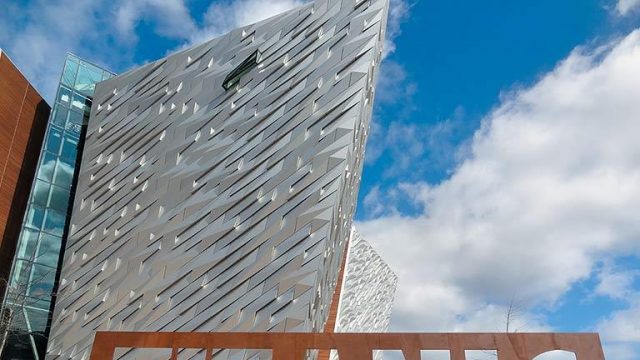From Titanic shame to pride, grief to celebration, and from boom to slump to boom again—Belfast’s reinvention is happening at the speed of…well, twenty-two knots. That was the velocity of the “practically unsinkable” RMS Titanic before her fatal encounter with an iceberg on April 15, 1912. Since then, the Titanic has remained largely submerged in our consciousness, only to surface occasionally in books and movies. But a hundred years has changed all that. Today Belfast, where the ship was built, is going to town commemorating the incident and inviting visitors to experience the city through the prism of the Titanic.
The year-long Titanic Centenary festival was flagged off on March 31 this year with the inauguration of the £97 million Titanic Belfast Visitor Centre at the dockyard where the ship was built. Its façade conveys the look of an iceberg, while its four sides resemble the bows of four ships. From its ice flake-shaped windows, you can see the new Belfast reclaiming its past to enhance the future.
I cross the road to enter the Centre, and stop before the lissome woman stretched out in what looks like a hands-free yoga pose, positioned in front of the building like a ship’s figurehead. On the right, a vertical Titanic sign poses a great photo opportunity and visitors stand between the letters, or weave in and out as the shutters click in quick succession. The 15m-long sign weighs fifteen tonnes, just like a Titanic anchor. Once inside, you cross the large compass engraved on the floor and pass the store and restaurant to visit the galleries.
The Titanic Belfast encourages you to see, touch and feel as it walks you through vignettes from the lives of some of the 2,000 plus people who were on board. You can experience these as you navigate the nine galleries spread over the building’s six storeys, with audiovisual and interactive enhancements.
The first gallery on Boomtown Belfast welcomes you through the gates of the Harland and Wolff shipyard that built the Titanic, the second lets you feel the excitement as construction progresses; the third is the Titanic readying for launch; in the fourth you get to peek into the svelte, well-fitted first class cabins with holographs of a man showing a woman passenger around as well as a second class bunker where two sisters get ready for bed. But the fifth gallery is what I’m most interested in—here, you can hear stories of crew and passengers, and be privy to their routine on board.
And then begins the tragic tale of the ship’s sinking, retold in a tech-sensory experience; its aftermath and the media blitz; and all the myths and legends that were spun out of “the most spectacular civilian maritime tragedy until that time”. The tour concludes with the ninth gallery, ‘Titanic Beneath’, featuring audio-visual footage of oceanographer Robert Ballard’s exploration of the Titanic’s wreckage that he discovered in 1985. The video is projected on a wall-sized screen, and you follow the camera underwater as you stand on a clear glass floor with the visual also moving beneath your feet, giving you the sense of being right there, two miles below sea level, on the ocean floor, in and out of the ship that is now home to sea animals, fish and plants.
“It is not a museum,” clarifies Howard Hastings, chairman of the Northern Ireland Tourism Board, “it’s the ultimate Titanic interactive experience”, of the making of not just the ship but of the people of Belfast. “We expect the Titanic Belfast to attract at least one million visitors a year,” he adds. Entering the banqueting hall, available for private bookings, I find it has the same handcrafted grand staircase, chandelier and wall clock that graced the Titanic and which James Cameron made famous in his 1997 film.
Tickets £13.50 (adults) and £6.75 (5-16 years of age). Open all days of the week 9am–7pm (Monday–Saturday) and 10am–5pm (Sunday). See titanicbelfast.com. For travels in the city, get a Belfast Visitor Pass that allows for unlimited travel with over 90 offers, including discounted tours (from £6.75; gotobelfast.com).




